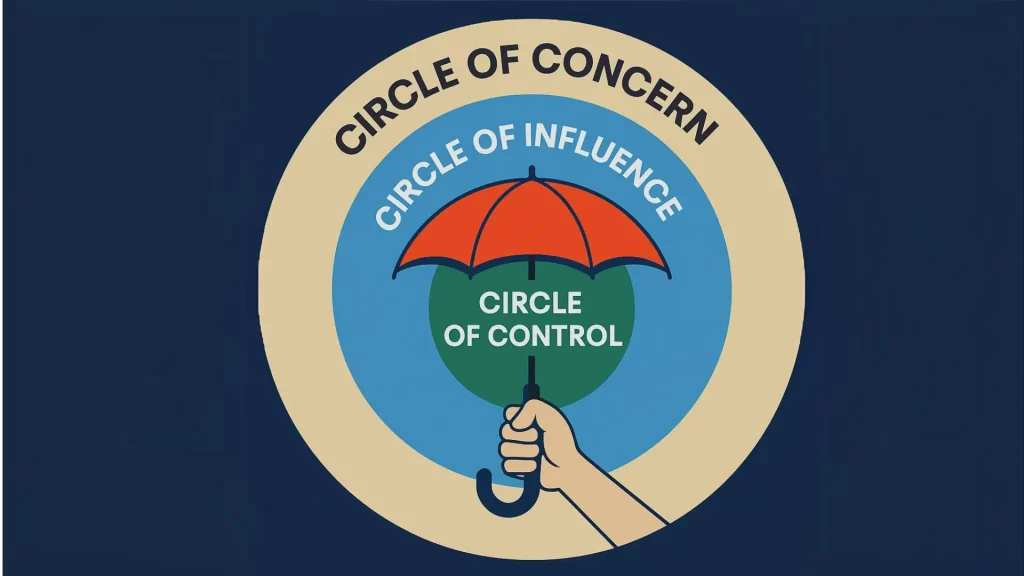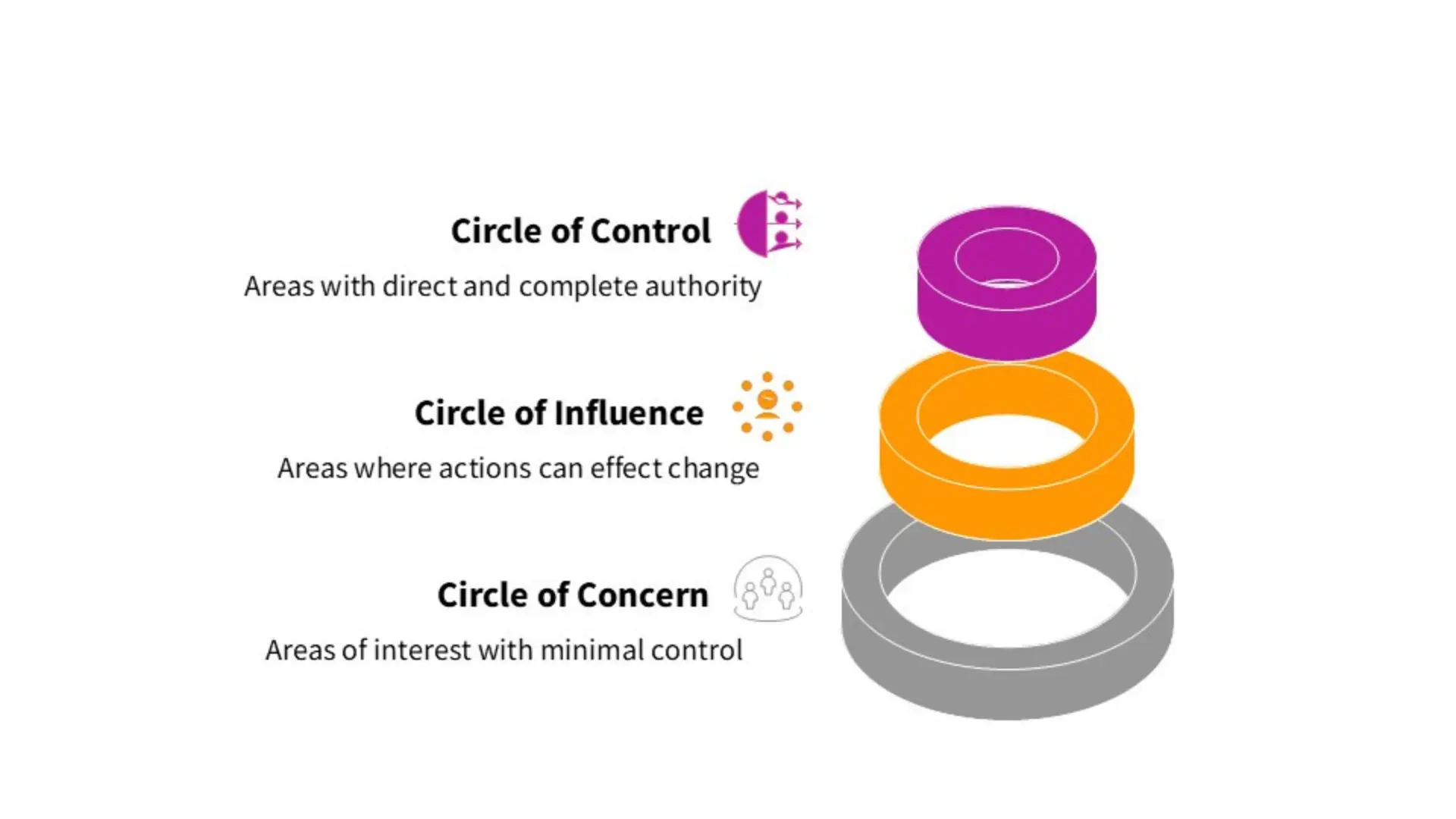Why do some managers thrive under pressure?


Monday morning. Emails are piling up, deadlines are closing in, and the pressure is already thick in the air. You glance around the office—or your Zoom screen—and notice something odd. While most people are scrambling, there’s that one manager who’s calm, composed, almost… unshaken.
What’s their secret? It’s not just years of experience or deep subject knowledge. It’s something quieter but more powerful—the ability to manage their own reactions. In a world that feels increasingly out of control, they’ve learned to lead from the inside out.

The Three Circles: Circle of Concern, Circle of Influence, and Circle of Control
The concept of the Three Circles—Circle of Concern, Circle of Influence, and Circle of Control—comes from Stephen Covey’s The 7 Habits of Highly Effective People. These circles offer a framework for understanding where your energy and focus should be directed in both personal and professional contexts. By expanding on these circles, you can better manage stress, enhance productivity, and become a more effective leader.
Circle of Concern:
This circle includes all the external factors we worry about but have little to no control over. It might include things like market conditions, company policies, or industry regulations. While these factors affect us, we can’t directly change them.
Circle of Influence:
This is the area where we can have an impact. It includes the things we can affect through relationships, persuasion, and communication—like motivating our teams or negotiating a new project approach.
Circle of Control:
The smallest circle, but the most powerful. This is where we control our actions, responses, and mindset. It’s about what we can directly influence through our behavior, emotions, and reactions.
When you are aware of these circles, the key to professional growth and leadership becomes clear: focus on expanding your Circle of Influence and strengthening your Circle of Control. Too much time spent in the Circle of Concern only drains your energy and attention without yielding results.
Let’s bring this concept to life with a story.
Meet Ananya, a mid-level manager at a growing tech startup. She’s passionate about her role, dedicated to her team, and driven by results. But she finds herself overwhelmed by the rapid pace of change at her company. Clients demand more, leadership pushes for faster product rollouts, and market conditions remain unpredictable. Every day feels like a battle against uncontrollable forces—and it’s starting to take a toll.
One Monday morning, Ananya is given a tight deadline by her senior manager to launch a new feature—a goal that seems almost impossible given the scope of the project and the limited resources. On top of that, leadership expects even higher performance. As the day progresses, the pressure builds. Ananya’s thoughts swirl with worries about the external factors—market shifts, client demands, leadership expectations—sapping her energy and focus.
But here’s where the Three Circles framework becomes her game-changer. Just before a crucial meeting with leadership, Ananya pauses to reflect. The frustrations and challenges she’s facing fall squarely in her Circle of Concern. While these external pressures are real and impactful, they are beyond her immediate control.
This realization shifts her mindset and helps her refocus her energy.
Let’s see how Ananya applies this framework to navigate her challenges.
Ananya begins by categorizing the issues she faces. The competitive landscape, client demands, and leadership pressure are all part of her Circle of Concern—factors she cannot directly influence. These pressures will continue to affect her, but she cannot change them right now. Instead of being consumed by them, she redirects her focus.
Next, Ananya turns her attention to her Circle of Influence. Here’s where she can make a tangible impact. She communicates effectively with her team, providing clarity and motivation. She influences how they approach the project, manage time, and collaborate. Ananya also engages in constructive conversations with leadership, ensuring they understand the realistic limitations of the project and the resources available.
Lastly, Ananya focuses on her Circle of Control. This is where she has the most power. Ananya chooses to remain calm, proactive, and composed. She understands that while external pressures are unavoidable, she controls how she reacts to them. By staying grounded and focused on her own actions and mindset, she leads by example.
Drawbacks of Focusing on the Uncontrollable
As Ananya continues to implement this framework, she encounters a common pitfall—temptation. The urge to fixate on things outside her control, like market conditions and client demands, is strong. When things go wrong, it’s easy to look for someone or something to blame. But Ananya realizes that when she spends too much time in the Circle of Concern, she only feels more stressed without solving any problems.
This is a trap many leaders fall into. Focusing too much on the uncontrollable can lead to frustration, burnout, and a loss of agency. The more energy you expend on things beyond your control, the less energy you have for things you can influence.
How to Overcome These Drawbacks
Ananya knows that the solution lies in consistently bringing her focus back to what she can control and influence. Here are a few strategies she implements:
- Mindfulness Practice: Ananya sets aside time each day for mindfulness exercises. This helps her stay present and focused on what she can influence, reducing anxiety about things outside her control.
- Actionable Prioritization: Every morning, Ananya identifies the top three priorities that fall within her Circle of Control. This helps her stay grounded and ensures her efforts are directed toward tasks she can manage.
- Building Influence: She dedicates time to strengthening relationships with key stakeholders. By maintaining proactive communication with leadership and peers, Ananya increases her Circle of Influence and shapes more favorable outcomes.
- Team Empowerment: Ananya delegates tasks based on her team’s strengths. This not only reduces her stress but also empowers her team, boosting their engagement and motivation.
By consistently practicing these strategies, Ananya regains a sense of control, even in the face of external pressures.
True leadership doesn’t require superhuman strength—it requires the wisdom to focus on what matters, the self-discipline to stay grounded, and the courage to lead by example. When you master your own mindset and actions, you transform not only your workplace but also your ability to handle any challenge with grace and effectiveness.
Reflect on your own Circle of Control and Influence at work. What external factors are you spending too much energy on? Here are some actionable steps you can take today:
- Identify one area where you’re focusing on something outside your control. Can you shift your focus back to something actionable?
- Set aside 10 minutes every day to practice mindfulness, bringing your attention back to what’s within your control.
- Strengthen your relationships with key stakeholders and communicate your priorities clearly to enhance your influence.






Very well said and helpful content to set Mantras for day-to-day life.